The first three apartments I lived in had no dishwasher — except for me, that is. For that matter, none of my early apartments had kitchen windows either.
I really felt like I had arrived by the time I owned my first dishwasher. Of course, saving quarters for the communal laundry machine in my apartment building went on for many more years to come!
If you have a dishwasher, I don’t need to tell you how wonderful they are!
However, it surprises some people to discover that there is a right and a wrong way to load a dishwasher. Do it wrong and you’ll end up with dishes not getting washed properly and possibly even breaking a few in the process.
Loading a dishwasher is easy as long as you follow a few simple rules:
First, quickly rinse dishes before putting them in the dishwasher in order to remove big chunks of food. Dishwashers can choke up unless you pay attention to this, and paying for a plumbers’ visit to unclog them can be expensive.
No need to fuss too much with this step (let the dishwasher do the washing!) but don’t leave it out.
Next, be sure to put glassware, coffee cups and plastic containers on the top rack, which was designed to hold them. If you have a lot of glasses that need washing, you may be tempted to put them on the bottom rack, but there is a higher probability that they will break there.
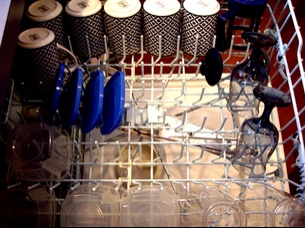
Since it’s generally hotter on the bottom than it is on the top, even dishwasher-safe plastic containers may melt on the bottom rack. Proceed with caution.
Plates, bowls, and anything that needs a stronger wash put on the bottom rack. Did you know that the top and bottom racks often have a different amount of water pressure? Who knew? You obviously need to exert less energy washing a water glass than a plate with dried-up tomato sauce on it!
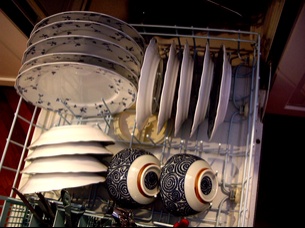
Naturally, silverware and utensils go in the special holder. Some people clump spoons together, forks together, and knives together. Others say, no, “nesting” the utensils means they don’t get cleaned properly — mix them up. Be warned: how one does or does not put silverware in the dishwasher can break up a beautiful friendship or marriage!
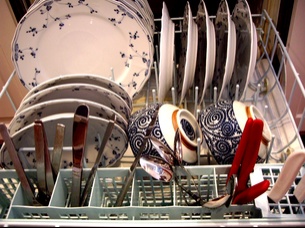
It’s important, in my view, to put sharp, pointed things (like knives and forks) pointing downward. (There is nothing worse than being impaled by utensils while loading – or unloading – the dishwasher!)
You should never put your good knives in the dishwasher. Something that big and that sharp just should not go in there — and it’s easy to wash good knives by hand. Small, inexpensive paring knives are often dishwasher-safe.
Always empty the bottom rack first. The glasses and cups on the top rack will often drip as you are unloading them (so many seem to have those little crevices on the bottom that accumulate water.) You won’t get the plates on the bottom all wet if you have already unloaded them first.
Never turn the dishwasher on and then go to bed. You never know when there could be a leak or a problem with your dishwasher! Turn it on after dinner so that it has finished running before you go to bed. (That’s actually a tip from most fire safety experts.)
Many people don’t turn it on until every square inch of space is filled, but I turn the dishwasher on every evening. It’s just too icky (technical term!) to think of dirty dishes hanging out in a sealed box overnight. If it’s not full, I just use the light setting.
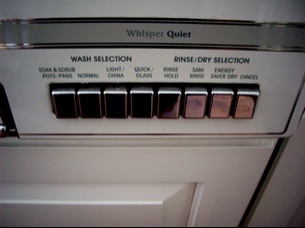
Many dishwashers have several settings. The settings on mine include: ‘pots & pans’, normal, light/china, quick/glass, ‘rinse & hold’, sani-rinse, and an ‘energy saver dry’.
The pots and pans cycle is the longest running cycle for really tough jobs.
The sani-rinse is a very hot rinse useful for really killing germs. I use it if someone in the house has a cold or the flu.
‘Energy-saver’ means the heating element to dry the dishes is not activated, and the dishes will take longer to dry on their own.
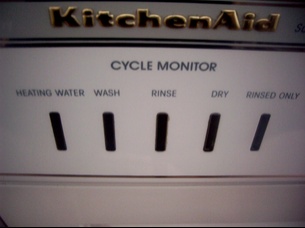
Inevitably, once you start the dishwasher you always find another glass or plate or spoon that needs to be washed. Generally speaking, in the beginning, while the water is heating, you can open the dishwasher and add that dirty dish. Then re-push the start button. Many dishwashers will have an indicator of some kind to tell you what part of the cycle it’s in. Some even have a pause button. If it’s already in the wash cycle then it’s too late to open the door, and you may flood the kitchen if you do. Alas, you may have to wash that last item by hand!
On a final note, here’s some personal advice if someone you really care about loads the dishwasher for you, but does it incorrectly. The first time, say nothing, thank them and turn out the lights. You want to encourage them to pitch in and help right?
By the third time they do it “not quite the way you think it should be done”, gently offer suggestions — with reasons. No-one likes being criticized, but if you use it as a form of education “By the way, did you know WHY they say you should…….?” You may get away with both your goals: getting it done right and keeping your relationship strong!
Does anyone else have any advice (or questions) about using dishwashers?
If you are new to startcooking, or are a regular visitor here, please consider subscribing for free.








































Shaula Evans said:
Free relationship advice at no extra cost…this blog just gets better and better.
Seriously—I knew you were supposed to put plastic lids on the top, but I never knew why. I had no idea the temperature and water pressure could be different. (Of course, now that you say it, it makes perfect sense.)
As for not running appliances while you sleep…I’ve been a victim of two floods. The first time, I took a nap while doing laundry…and flooded the downstairs apartment. The second time (different building! actually even a different country), my upstairs neighbour’s laundry machine flooded in the night, and found out when my downstairs neighbour banged on the door around 1 am, because water was pouring through my ceiling then through my floor, to come out through the downstairs ceiling. (It was a BIG mess, but insurance covered it, and the workmen who came in to repair my ceiling and walls did an incredibly beautiful job.)
I’ve seen relationships founder over toilet seats, dishwashers, and who takes out the garbage. Learning to give advice effectively in order to reduce domestic friction is REALLY great advice, Kathy.
Okay, now I’m off to point all my lovelorn college friends at your dishwasher post…